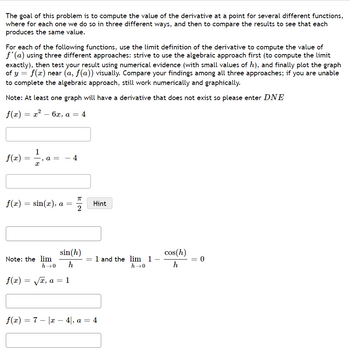
Advanced Engineering Mathematics
10th Edition
ISBN: 9780470458365
Author: Erwin Kreyszig
Publisher: Wiley, John & Sons, Incorporated
expand_more
expand_more
format_list_bulleted
Question
Please answer fast i will rate for

Transcribed Image Text:The goal of this problem is to compute the value of the derivative at a point for several different functions,
where for each one we do so in three different ways, and then to compare the results to see that each
produces the same value.
For each of the following functions, use the limit definition of the derivative to compute the value of
f'(a) using three different approaches: strive to use the algebraic approach first (to compute the limit
exactly), then test your result using numerical evidence (with small values of h), and finally plot the graph
of y = f(x) near (a, f(a)) visually. Compare your findings among all three approaches; if you are unable
to complete the algebraic approach, still work numerically and graphically.
Note: At least one graph will have a derivative that does not exist so please enter DNE
ƒ(x) = x² − 6x, a = 4
f(x)
f(x)
=
f(x)
=
1
=
x
"
a = - 4
Note: the lim
sin(x), a =
π
2
sin (h)
h
h→0
√x, a = 1
Hint
= 1 and the lim 1
h→0
f(x) = 7 x − 4|, a = 4
cos(h)
h
= 0
Expert Solution
This question has been solved!
Explore an expertly crafted, step-by-step solution for a thorough understanding of key concepts.
This is a popular solution
Trending nowThis is a popular solution!
Step by stepSolved in 3 steps with 3 images

Knowledge Booster
Similar questions
- Lexi hiked 3 miles down into the hill at 3 miles per hour, then 3 miles back out of the hill at 1 mile per hour. how to a distance-time graph. What is the average speed?arrow_forwardThe vancouver real estate market has slowed in the last 2 years. A condo valued at 420,000 has lost 18% of its value. Find the loss in valuearrow_forwardRattan enjoys the outdoors.He can bike 5 times faster than he can jog. To cover 20km path, Rayyan needs 2 hours more of he jogs than if he bikes. What is the average speed in km/h on a bike? Round your answer to the nearest tenth if necessary.arrow_forward
arrow_back_ios
arrow_forward_ios
Recommended textbooks for you
 Advanced Engineering MathematicsAdvanced MathISBN:9780470458365Author:Erwin KreyszigPublisher:Wiley, John & Sons, Incorporated
Advanced Engineering MathematicsAdvanced MathISBN:9780470458365Author:Erwin KreyszigPublisher:Wiley, John & Sons, Incorporated Numerical Methods for EngineersAdvanced MathISBN:9780073397924Author:Steven C. Chapra Dr., Raymond P. CanalePublisher:McGraw-Hill Education
Numerical Methods for EngineersAdvanced MathISBN:9780073397924Author:Steven C. Chapra Dr., Raymond P. CanalePublisher:McGraw-Hill Education Introductory Mathematics for Engineering Applicat...Advanced MathISBN:9781118141809Author:Nathan KlingbeilPublisher:WILEY
Introductory Mathematics for Engineering Applicat...Advanced MathISBN:9781118141809Author:Nathan KlingbeilPublisher:WILEY Mathematics For Machine TechnologyAdvanced MathISBN:9781337798310Author:Peterson, John.Publisher:Cengage Learning,
Mathematics For Machine TechnologyAdvanced MathISBN:9781337798310Author:Peterson, John.Publisher:Cengage Learning,


Advanced Engineering Mathematics
Advanced Math
ISBN:9780470458365
Author:Erwin Kreyszig
Publisher:Wiley, John & Sons, Incorporated

Numerical Methods for Engineers
Advanced Math
ISBN:9780073397924
Author:Steven C. Chapra Dr., Raymond P. Canale
Publisher:McGraw-Hill Education

Introductory Mathematics for Engineering Applicat...
Advanced Math
ISBN:9781118141809
Author:Nathan Klingbeil
Publisher:WILEY

Mathematics For Machine Technology
Advanced Math
ISBN:9781337798310
Author:Peterson, John.
Publisher:Cengage Learning,

